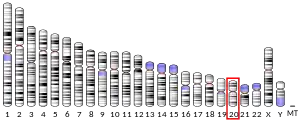Extracellular sulfatase Sulf-2 is an enzyme that in humans is encoded by the SULF2 gene.[5][6]
Function
Heparan sulfate proteoglycans (HSPGs) act as coreceptors for numerous heparin-binding growth factors and cytokines and are involved in cell signaling. Heparan sulfate 6-O-endosulfatases, such as SULF2, selectively remove 6-O-sulfate groups from heparan sulfate. This activity modulates the effects of heparan sulfate by altering binding sites for signaling molecules (Dai et al., 2005).[supplied by OMIM][6]
References
- 1 2 3 GRCh38: Ensembl release 89: ENSG00000196562 - Ensembl, May 2017
- 1 2 3 GRCm38: Ensembl release 89: ENSMUSG00000006800 - Ensembl, May 2017
- ↑ "Human PubMed Reference:". National Center for Biotechnology Information, U.S. National Library of Medicine.
- ↑ "Mouse PubMed Reference:". National Center for Biotechnology Information, U.S. National Library of Medicine.
- ↑ Morimoto-Tomita M, Uchimura K, Werb Z, Hemmerich S, Rosen SD (December 2002). "Cloning and characterization of two extracellular heparin-degrading endosulfatases in mice and humans". The Journal of Biological Chemistry. 277 (51): 49175–49185. doi:10.1074/jbc.M205131200. PMC 2779716. PMID 12368295.
- 1 2 "Entrez Gene: SULF2 sulfatase 2".
Further reading
- Nakajima D, Okazaki N, Yamakawa H, Kikuno R, Ohara O, Nagase T (June 2002). "Construction of expression-ready cDNA clones for KIAA genes: manual curation of 330 KIAA cDNA clones". DNA Research. 9 (3): 99–106. CiteSeerX 10.1.1.500.923. doi:10.1093/dnares/9.3.99. PMID 12168954.
- Nagase T, Ishikawa K, Kikuno R, Hirosawa M, Nomura N, Ohara O (October 1999). "Prediction of the coding sequences of unidentified human genes. XV. The complete sequences of 100 new cDNA clones from brain which code for large proteins in vitro". DNA Research. 6 (5): 337–345. doi:10.1093/dnares/6.5.337. PMID 10574462.
- Fossey SC, Mychaleckyj JC, Pendleton JK, Snyder JR, Bensen JT, Hirakawa S, Rich SS, Freedman BI, Bowden DW (August 2001). "A high-resolution 6.0-megabase transcript map of the type 2 diabetes susceptibility region on human chromosome 20". Genomics. 76 (1–3): 45–57. doi:10.1006/geno.2001.6584. PMID 11549316.
- Dai Y, Yang Y, MacLeod V, Yue X, Rapraeger AC, Shriver Z, Venkataraman G, Sasisekharan R, Sanderson RD (December 2005). "HSulf-1 and HSulf-2 are potent inhibitors of myeloma tumor growth in vivo". The Journal of Biological Chemistry. 280 (48): 40066–40073. doi:10.1074/jbc.M508136200. PMID 16192265.
- Morimoto-Tomita M, Uchimura K, Bistrup A, Lum DH, Egeblad M, Boudreau N, Werb Z, Rosen SD (November 2005). "Sulf-2, a proangiogenic heparan sulfate endosulfatase, is upregulated in breast cancer". Neoplasia. 7 (11): 1001–1010. doi:10.1593/neo.05496. PMC 1502017. PMID 16331886.
- Uchimura K, Morimoto-Tomita M, Bistrup A, Li J, Lyon M, Gallagher J, Werb Z, Rosen SD (2006). "HSulf-2, an extracellular endoglucosamine-6-sulfatase, selectively mobilizes heparin-bound growth factors and chemokines: effects on VEGF, FGF-1, and SDF-1". BMC Biochemistry. 7: 2. doi:10.1186/1471-2091-7-2. PMC 1386684. PMID 16417632.
This article is issued from Wikipedia. The text is licensed under Creative Commons - Attribution - Sharealike. Additional terms may apply for the media files.



